Chapter 5 Reaction To Colonial Rule: Cooperation And Revolt Salient points – At a glance
1. Ramkrishna Mission:
Ramakrishna Mission was founded by Swami Vivekananda and his associates on May 1, 1897. It aimed at reflecting Guru Ramkrishnadev’s ideal of serving fellow beings as God.
The members of Ramakrishna Math and Mission have been serving mankind irrespective of caste, creed, or religion till today.
The main center of the Mission is Belur on the banks of the Ganga and is popularly known as Belur Math. These institutions follow the Vedantas and recognize image worship.
They serve society through schools, libraries, health centers, and orphanages established by them.
Read and Learn More WBBSE Solutions For Class 8 History
2. Academic Association:
Derozio founded a debate association named Academic Association in 1828 at the garden house of Sri Krishna Sinha at Manicktala.
Derozio was the president and his student Umesh Chandra Bose was the secretary of the association. In fact, this association was the first student organization in India.
At the various conferences of this association, discussions and debates on philosophy, history, sociology, casteism in Hindu society, untouchability, and idolatry were held.
Class 8 History WBBSE
3. Damin I Koh:
The word Damin l Koh literally means a ‘hilly frontier province’.
The Santhals, a tribal group who inhabited the forested areas of Bengal and Bihar, became victims of oppression by the landlords and moneylenders as a result of the introduction of the Permanent Settlement system.
So they left their original homes and shifted to Rajmahal Hills and a part of the forested area of Murshidabad. They cleared the forests and began to cultivate the land.
They named this place of new settlement ‘Damin-i-koh’.
4. Munda Ulgulan:
The Munda Revolt that broke out in 1899-1900 was known as ‘Munda Ulgulan’. The land of the Mundas was being slowly taken away by outsiders.
So the rebellion aimed at driving away the outsiders and establishing self-rule under their leader Birsa.
Millions of Mundas joined hands together and took the pledge of terminating the British domination over their land.
The Ulgulan come to an end with the death of Birsa Munda and the cruel suppression of the revolt by the British.
5. Nil Darpan:
The drama ‘Nil Darpan’ was written by Dinabandhu Mitra in 1858-59 on the backdrop of the Indigo Revolt in Bengal. It was translated into English by Michael Madhusudan Dutta.
This translation revealed the torture and oppression meted out to the cultivators by the indigo planters.
6. Enfield Rifle:
In 1857 the British authorities decided that the sepoys would have to use the new Enfield rifle instead of the old ‘Brown base’ muskets.
The outer shell of the cartridge of the Enfield rifle was made of the fat of cow and pig. The shells had to be bitten off before fitting the cartridge into the rifle.
This enraged both Hindus and Muslims as this directly hurt their religious sentiments and they broke out into revolt.
Class 8 History WBBSE
7. Mopala Revolt:
Many Arabian traders lived on the Malabar coast in South India and their descendants were called Mopalas. The Mopalas were mainly agriculturists, small traders, and fishermen.
When the Zamindars imposed illegal taxes upon them and raised. the rate of revenue they became rebellious.
The revolt of these Mopala peasants against the tyranny of the landlords in 1873-1896 is known as Mopala Revolt. However, this revolt was suppressed by the army.
8. Sepoy Revolt in Meerut:
On May 10, 1857, some sepoys were speaking to the civilians near the army barrack in Meerut UP.
On the day before, 85 sepoys were imprisoned and kept in chains by Colonel Carmichael Smith for refusing to use the Enfield Rifle.
At that time a regiment of white soldiers was marching toward the church. A young boy suddenly raised a hue saying ‘Whites are coming’, which created a misconception that the Whites were coming to imprison the Indian sepoys.
This infuriated the civilians who joined the Indian soldiers and captured the arsenal as well as killed some British soldiers. Thus the sepoy revolt was triggered off in Meerut.
9. Bamboo Castle:
The Wahabi Movement in Bengal was led by Titu Mir or Titu Mian.
He declared himself as the ‘Badshah’ and began to carry on a parallel administration from a bamboo castle constructed at Narkelberia.
This was at a distance of 10km from the Baduria police station of 24 Parganas.
His Prime Minister was Mainuddin, his Commander in chief was his nephew Ghulam Masum and Mishin Shah was the Chief of Espionage.
William Bentinck sent the 10th infantry under Colonel Stuart to suppress Titu Mir. The army destroyed the Bamboo Castle and Titu was killed.
Class 8 History WBBSE
10. Shuddhi Or Purification Movement:
A split could be seen in the Honda society due to large-scale conversion.
So Swami Dayanand, the founder of Arya Samaj tried to protect Hindu society from disintegrating.
He took up a purification programme to reconvert the Hindus who had adopted other religions, to bring the non-Hindus into the fold, to resist the influence of other religions, and to build up a unified Indian society.
Chapter 5 Reaction To Colonial Rule: Cooperation And Revolt Topic A Reformation Movement Descriptive Questions
1. Discuss the contribution of Raja Ram- Mohan Roy as a social reformer.
Answer:
Contribution Of Raja Ram- Mohan Roy As A Social Reformer:-
Introduction:
Raja Rammohan Roy was a man of modern rationalistic thoughts and a secular outlook. He was the first person to dream and speak of a superstition-free society and religion.
It was due to his constant efforts to reform Indian society that he was called the ‘Maker of modern India’.
Contribution Of Raja Rammohan Roy As A Reformer
1. Abolition of Suttee:
in the then-Hindu society, a widow was forcibly burnt on the same pyre as her dead husband.
Rammohan gave the interpretation of different scriptures to show that Sati was not sanctioned by religion.
He tried to build up public opinion against the practice. The then Governor-General Lord William Bentinck finally abolished Sati by issuing Regulation no 17.
Class 8 History WBBSE
2. Opposition of casteism:
Rammohan was absolutely against casteism. He wrote essays and articles against the caste distinctions prevalent in society and also translated his protests into Bengali.
3. Progress of Women:
Rammohan felt that society and civilization would suffer a setback if women were not given their due rights.
So he wanted to solve the issues of women and improve their condition. He gave priority to six things
- to establish the rights of wives and daughters on the property of the husbands and fathers respectively,
- to spread women’s education smoothly and universally,
- to arrange for widow remarriage,
- to rectify the laws concerning the daughter’s marriage,
- to ban child marriage,
- to protect women from the vices of Kulinism.
4. Other reforms:
1. Protest against restricting the freedom of the press:
The British government tried to enact laws to restrict the freedom of the press.
Rammohan raised a strong protest and sent petitions to the Kolkata Supreme Court and also to the Monarch of England in 1823.
2. Protest against polygamy:
He also protested against polygamy which was prevalent among men at that time.
Class 8 History WBBSE
3. Opposition to Jury laws:
Rammohan also protested against the discriminatory Jury Laws in 1827.
4. Abolition of Zamindari:
Rammohan demanded that the government should do away with the Zamindari system and make direct land lease agreements with the farmers.
5. Appointment at high posts:
Rammohan vehemently criticized the government for not appointing Indians to high posts in the government.
Question 2 Assess the contribution of Ishwar Chandra Vidyasagar as a reformer.
Answer:
Contribution Of Ishwar Chandra Vidyasagar As A Reformer:-
Introduction:
Ishwarchandra Vidya Sagar was one of those reformers who made a significant contribution during the Renaissance period of Bengal in Bengal in the 19th century.
Rabindranath paid a tribute to Vidyasagar by saying that Providence had entrusted Vidyasagar with the task of civilizing the land of Bengal.
Contribution Of Vidyasagar As A Reformer
1. As a social reformer:
1. Widow Remarriage:
It was under his initiative that a petition containing the signature of many distinguished persons supporting widow remarriage.
was sent to the members of the Indian Legislative Council on 4th October 1855.
Then the British government under Dalhousie passed the Widow Remarriage Act on 26th July 1856 by issuing Regulation no 15.
Class 8 History Solution WBBSE
2. Opposition to child marriage:
Vidyasagar presented the torment and agony of the lives of young Hindu widows for the first time in the first edition of ‘Sarbashuvakari Patrika’.
It was due to his constant efforts that the British government passed legislation that the minimum age for a girl’s marriage should be 10 years.
3. Protest against polygamy:
Vidyasagar sent a petition containing the signatures of 50,000 persons opposing polygamy to the British government in 1855 with
the help of the Maharaja of Burdwan Mahtab Chand. The government appointed a committee to make legislation to stop polygamy.
4. Other reforms:
Vidyasagar also condemned casteism, untouchability, child sacrifice in Gangasagar, and drunkenness and invited others to join in the protest.
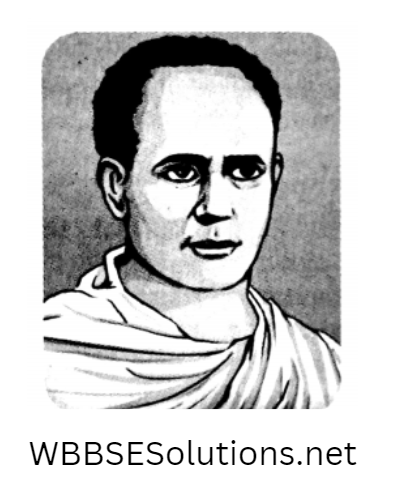
2. As an educational reformer:
1. Spread of women’s education:
Vidyasagar, the pioneer of women’s education, established the Hindu Balika Vidyalaya in 1849 with the help of John Elliot Drinkwater Bethune.
The school is called Bethune School. He established girls’ schools in different districts on his own initiative and about 1300 girls were provided education in these schools.
He established the Bhagwati Vidyalaya at Birsinha in 1890 in memory of his mother.
Class 8 History Solution WBBSE
2. Introduction of modern curriculum:
He wrote books like ‘Varnamala’, ‘Kathamala’ and ‘Bodhodaya’ and introduced subjects like arithmetic, geometry, ethics, political science, and physical education into the curriculum of Sanskrit College.
3. Increasing the facility of higher education:
Vidyasagar admitted students from all sections of society to Sanskrit College. He also founded the Metropolitan Institution (Modern Vidyasagar College) in 1870 to impart higher education.
Question 3. Give an account of Derozio and the Young Bengal Movement.
Answer:
Introduction:
A group of youths in Bengal was enlightened by Western education in the first half of the 19th century. They organized a social reform movement under
the leadership of Derozio who was a professor at Hindu College and was inspired by the philosophy of Bentham. This movement was popularly known as Young Bengal Movement.
Derozio And Young Bengal Movement
1. Ideals:
Derozio always preached in favor of rationalism and independent thinking. The young Bengal group under his leadership began to protest against the prevalent beliefs and superstitions.
They wanted to do away with all pretensions and false elaborate rituals. Derozio always advised his followers to uphold truth and get rid of falsehood.
Class 8 History Solution WBBSE
2. Emergence of Young Bengal Association:
A group of youths was attracted by the rationalistic philosophy of Western thinkers like Rousseau, Voltaire, Hume, and Locke.
This group, inspired by the ideals of Derozio, a professor of History and English Literature at Hindu College, emerged as the ‘Young Bengal Association’.
3. Social reforms:
The members of the Young Bengal Association protested against the superstitions, casteism, and untouchability prevalent in Hindu society.
They wanted to do away with the Sati system and also protested against other vices like slavery, violence against women, child marriage, polygamy, and bonded labor.
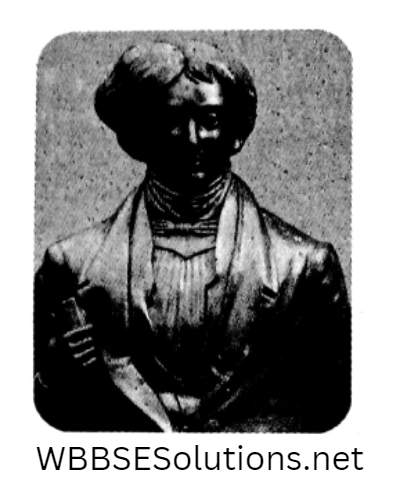
4. Derozio’s contribution:
Derozio advised his followers to discard superstitions, develop a rationalistic outlook and search for truth instead of taking things for granted.
His poems ‘Fakir of Janghira’ and ‘Swadesher Pran’ reflect his patriotism. As a teacher, he always tried to make his students rational and capable of independent thinking.
He built up the first students’ organization in India, which was called the ‘Academic Association’, in 1828.
5. End of the Movement:
After the death of Derozio, his students continued the movement for some time.
When most of them deserted and became established in their personal life, the movement came to an end.
The movement was mainly confined to the city and they were indifferent toward the demands and grievances of the masses.
The movement also failed due to their deviation from ideals, rashness, and lack of any constructive agenda.
Class 8 History Solution WBBSE
Question 4. Assess the contribution of Veersalingam Pantulu in the establishment of modern Andhra.
Answer:
Contribution Of Veersalingam Pantulu In The Establishment Of Modern Andhra:-
Introduction:
Kandukuri Veersalingam Pantulu was the father of the Renaissance in Andhra Pradesh. He tried to pave the way for social development by raising the moral standard of the man.
Mahadev Govind Ranade had called him ‘Ishwarchandra Vidyasagar of the south’ for his social reforms.
Contribution Of Veersalingam-
1. Social vehemently development:
Veersalingam condemned casteism, untouchability, and oppression of the lower classes by the upper classes.
He also protested against the corruption and tyranny of British judges and officials.
He founded some social services organizations like Sangha Sanskaar Samajam (1876), Prarthana Samajam (1878), and Stri Punarvivah Samajam (1880).
2. Telugu Literature:
Veersalingam was the father of Telugu literature and journalism. He was the pioneer in writing novels, dramas, physical science, and history books.
He composed ‘Satyaraja Purvadesh Yatralu’ and ‘Rajshekhara Charitrama’ in imitation of Jonathan Swift’s ‘Gulliver’s Travels’ and Goldsmith’s ‘The Vicar of Wakefield’ respectively.
His authoritative work was ‘The Lives of Telugu Poets’.
3. Women’s Welfare:
He voiced his protest against child marriage, polygamy, the devadasi system, and keeping concubines and professional dancers and songstresses.
He founded Rajamundri Samaj Sanskara Samity (1878).and Vidhava Vivah Samity (1881).
The first widow remarriage was held in Andhra Pradesh under his initiative on 11th December 1881.
He also established homes for widows in Mysore (1907) and Bangalore (1910). He was helped in all these activities by his wife and inseparable companion Rajlaxmi.
Class 8 History Solution WBBSE
4. Spread of mass education:
He set up girls’ schools in Doaleshwaram (1878) and Rajahmundry (1884) to spread mass education. He also established schools for women, Harijans, and laborers.
He appointed ladies from lower classes who were trained in vocational education as teachers.
Some of the institutions founded by him were Balbharati Samity, National Hich School, and Vande Mataram High School.
Question 5. Assess the contribution of Shri Narayan Guru in the social reformation and cultural spheres of South India in the 19th. century.
Answer:
Contribution Of Shri Narayan Guru In The Social Reformation And Cultural Spheres Of South India In The 19th. Century:-
Introduction:
Shri Narayan Guru was a saint, thinker, and reformer who led the religious and social movements in Kerala in the second half of the 19th century.
1. Principles:
The three main principles or ideals of the Narayan Guru were
- to educate oneself and get rid of superstitions;
- to become united to achieve power;
- to bring about economic development through industrialization. He founded an organization named ‘Shri Narayan Dharma Paripalan Yogam on 15th May 1903 to preach his ideals.
Contribution Of Narayan Guru-
1. Protest against untouchability:
The main teaching of Shri Narayan Guru was that ‘man is one race, religion is one and God is one’.
He condemned untouchability and tried to build up public opinion in favor of allowing the backward classes to enter the temples freely and also for establishing their social rights.
2. Vaikam Satyagraha:
Most of the people of Kerala belonged to the Lihava sect. They were not allowed to use the path of a Hindu temple at Vaikam.
Narayan Guru was the first person to take up this cause and he started a movement called the ‘Vaikam Satyagraha’ in 1924 to enable these people to use the said path.
An Ijhava priestly class was created and many of the Ijhavas were appointed in the kitchens.
This created confidence among these people who were considered to belong to a lower class.
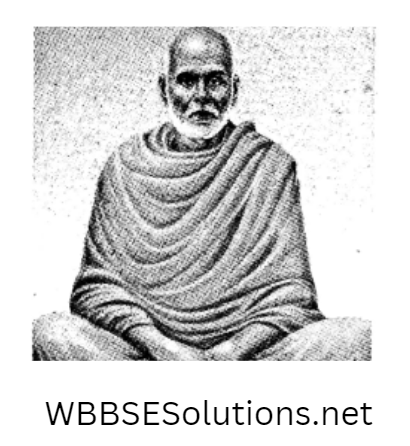
3. Establishment of educational institutions:
Narayan Guru wanted to uplift the cultural and moral standards of the lower caste people through education. So he organized a fund and called for donations.
Class 8 WBBSE History Question Answer
1. Evaluation:
Initially, the reform movement led by Narayan Guru was aimed at the development of the Ijhavas, but it, later on, became an anti-casteism movement.
Thus Shri Narayan Guru added a new dimension to the Hindu reform movement by establishing social rights of the backward classes in Kerala.
Question 6. Assess the contribution of Jyotirao Phule to the reform movement in Maharashtra in the 19th century.
Answer:
The Contribution Of Jyotirao Phule To The Reform Movement In Maharashtra In The 19th Century:-
Introduction:
The name of Jyotirao Govind Phule deserves a special mention in the social reform movement in Maharashtra in the 19th century. He was determined to bring about
the universal development of all lower caste people including the Sudras.
Jyotirao Phule and his wife Savitribai made a significant contribution to the social reform movement in Maharashtra.
Contribution Of Jyotirao Phule-
1. Rationalistic Reforms:
In his early life, Jyotirao Phule was a devotee of Christianity and Islam and hated Hinduism.
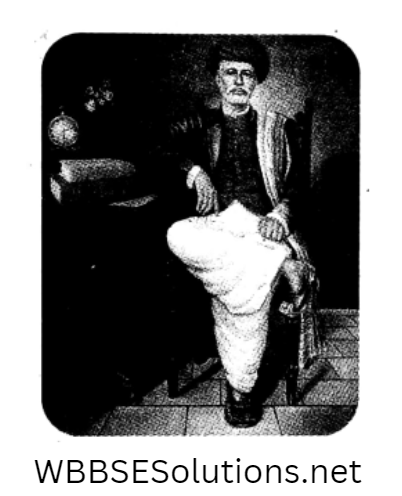
2. Social reforms:
Jyotirao Phule and his wife strongly protested against the predominance of Brahmins in society, casteism, and the immense misery of the sudras and women.
He established the ‘Home for Prevention of Infanticide’ to provide shelter to illegitimate children. Again, he founded
The Satyashodhak Samaj in 1873 secured social justice for the backward and downtrodden classes.
Class 8 WBBSE History Question Answer
3. Opposition of Brahmins:
Jyotirao Phule thought that the Brahmins were the main obstacles in the path of establishing the fundamental rights of the poor, untouchable, and lower caste people in society.
So he challenged Brahmanism in his work ‘Gulamgiri’ in 1872.
He preached against Brahiminism among the lower caste people like Kunur, Mali, Mang, and Mahar and thus laid the foundation of the antiBrahmanism movement.
4. Women’s welfare:
He vehemently protested against child marriage, polygamy, and female infanticide.
He established girls’ schools for the lower class girls and also organized a strong movement in favor of widow remarriage.
5. Educational reforms:
Jyotirao Phule thought that the Sudras and other lower caste people should be brought under the fold of Western education.
So he and his wife founded the first girls’ school in Poona in 1851.
He was helped by other reformists like Sadashiv and Ballal Paranjape in his educational activities.
1. Evaluation:
Jyotirao Phule, who was imbued with rationalistic and modern ideas, worked for the universal development of the lower classes of Maharashtra throughout his life.
He did not even hesitate to take the help of the British government to protect the lower castes from the grip of the Brahmins.
According to DJ Key, Rai Bahadur Vithalrao Krishnaji Bhandarkar, an eminent reformer, conferred the. title of ‘Mahatma’ on Jyotirao Phule on 11th May 1888.
Question 7. Give a brief description of the reform movement under the leadership of the Brahmo Samaj.
Answer:
Reform Movement Under The Leadership Of The Brahmo Samaj:-
Introduction:
Rammohan Roy founded the ‘Atmiya Sabha’ in 1815 to remove religious bigotry and superstitions from society. The Brahmo Sabha emerged out of this Atmiya Sabha in 1828.
After the demise of Rammohan in 1838 Maharshi Devendranath Tagore took up the responsibility. Keshav Chandra Sen joined the Samaj in 1858.
Class 8 WBBSE History Question Answer
The Brahmo movement received momentum under the initiative of Keshav Chandra Sen and Vijay Krishna Goswami.
Reform Movement Under Brahmo Samaj
1. Religious reforms:
The motive behind the foundation of the Brahmo Samaj was to worship the one and only Brohmo.
Some new rules of conduct, rituals, and initiation processes were introduced by Devendranath Tagore.
The members of Brahmo Samaj opposed idolatry, believed in monotheism (one God), and emphasized the performance of rites and rituals according to the Vedas, Puranas, and Upanishads.
Devendranath Tagore and Gaganendranath Tagore organised a national fair called Chaitra Mela or Hindu Mela in 1867 to reestablish the glory of ancient Hinduism.
2. Social reforms:
The main aim of the Brahmo Samaj was to remove social superstitions, spread women’s education, and legalize widow remarriage.
The British government passed an Act in 1872 which prohibited child marriage and polygamy and legalized inter-caste marriage. This was the fruit of Keshav Chandra Sen’s efforts.
William Bentinck banned Sati on 4th December 1829 with the cooperation of Rammohan.
Keshav Chandra expressed his support for the women’s liberation movement through his journals Bamabodhini and ‘Paricharika’.
t was again due to this that daughter’s rights to her parental property were recognized.
3. Educational reforms:
The ‘Indian Mirror’, edited by Keshav Chandra was published with a view of spreading universal education for the masses.
The subjects like social science and physics were introduced in Vedanta College established by Rammohan and Hare School.
Keshav Chandra founded the Native Ladies’ Formal School in 1871 which was renamed as Native Ladies’ Institution (now Victoria Institution) in 1882.
He also established a night school at Kolutolla, Calcutta College in 1862, and Albert College in 1872.
Class 8 WBBSE History Question Answer
Question 8. What was the role of Arya Samaj in the reform movements? movements
Answer:
Introduction:
Reform started in western and north-western India in the second half of the 19th century to protect Hinduism from the growing influence of Christian missionaries.
The reform movement in Punjab was led by the Arya Samaj. Their main aim was to influence the masses as well as the uneducated classes.
Role Of Arya Samaj In The Reform Movements
1. Foundation:
The Arya Samaj was founded in Punjab by Swami Dayanand Saraswati in 1875. However, its structure and principles were formulated at Lahore in 1877.
2. Ideals:
Swami Dayanand believed in the Vedas and wanted that Hinduism should be based exactly on the Vedas.
He thought that some selfish persons had deliberately misinterpreted the Vedas and thus stained the popularity of Hinduism.
3. Social reforms:
1. In different spheres:
The members of Arya Samaj constantly fought against social, malpractices, and inequality.
They tried to enhance the prestige of women by spreading women’s education. They strongly protested against casteism and untouchability.
2. Purification (Shuddhi) movement:
Swami Dayanand introduced the purification program to resist the conversion of Hindus. Arrangements were made to initiate non-Hindus and convert.
He wanted to unify the country by removing foreign influence from society and by establishing one nation and one religion.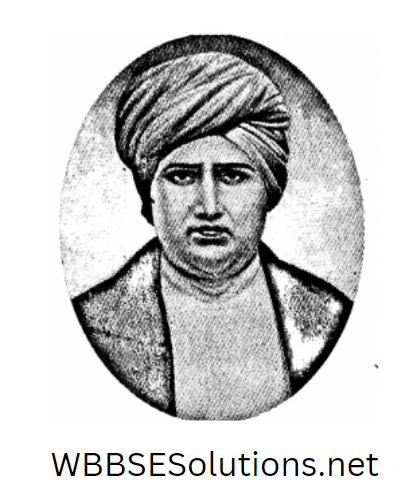
4. Educational reforms:
The followers of Swami Dayananda established many schools and colleges to spread western education.
The Dayanand Anglo Vedic college in Lahore and Kangri Gurukul Vidyalaya (a Vedic educational institution) near Haridwar are some examples.
Class 8 WBBSE History Question Answer
5. Religious reforms:
Swami Dayanand preached that the Vedas contained the words of God, it was infallible and the source of all knowledge.
However, he opposed the rituals based on Puranas, idolatry and polytheism (many Gods).
Question 9. Compare Rammohan and Dayanand as leaders of reform movements.
Answer:
Comparing Rammohan And Dayanand As Leaders Of Reform Movements:-
Both Rammohan and Dayanand Saraswati were Indian reformers belonging to the 19th century. Rammohan, the ‘Father of Indian Renaissance’ and the ‘maker of modern.
India’ wanted to remove the social and religious superstitions and make a new India by combining Orientalism and Anglicism.
On the other hand, Dayanand, a monotheist and an orientalist, wanted to make an advanced India through the revival of Hinduism.
There are both similarities and dissimilarities between the reform movements led by Rammohan Roy and Dayanand Saraswati.
Comparison Between Rammohan And Dayanand
1. Similarities:
1. Educational qualification:
While Rammohan was a multi linguist, rationalist, and Vedic scholar, Dayanand was a great Sanskrit and Vedic scholar.
2. Liberal thinking:
Like Rammohan, Dayanand also opposed casteism, racialism, idolatry and child marriage and supported women’s education, widow remarriage, monotheism and sea voyages.
3. Compositions:
Rammohan wrote books like ‘Vedanta Grantha’ and ‘Vedanta Saar’ while Dayanand wrote ‘Satyartha Prakash’ and ‘Ved Bhasya’.
2. Dissimilarities:
1. Movement strategies:
The Brahmos mainly appealed to the educated and English-literate groups but the Arya Samajists preached among the common masses.
Unlike Rammohan, Dayanand never supported rationalism or western science and knowledge.
The Arya Samajists exercised more influence over Punjab and UP than the Brahmos.
Class 8 WBBSE History Question Answer
2. Ideals:
Dayanand believed only in the Vedas but Rammohan regarded the Vedantas and Upanishads as the essence of Hinduism.
Dayanand believed that the Vedas contained all religious truths and scientific data. He emphasized faith and devotion for more than one reason.
On the other hand, Rammohan assimilated the essence of Oriental and Western thoughts, transcribed it himself and tried to share it with his countrymen.
1. Comments:
Dayananda talked talked about character building by following Vedic ideals and thereby elevating moral standards.
According to him, the priest had no place between God and his devotee.
On the other hand, Rammohan had tried to preserve the ideals of the past and combine western rationalism and modernism with them and thus bring about a renaissance.
Though Dayanand could send his message to the common people, Rammohan’s ideals could influence only a handful of intellectuals and upper classes.
Question 10. Discuss the contribution of Prarthana Samaj in the social reformation of Maharashtra in the 19th century.
Answer:
Contribution Of Prarthana Samaj In The Social Reformation Of Maharashtra In The 19th Century:-
Introduction:
The Prarthana Samaj made a praiseworthy contribution to the social reformation of Maharashtra in the 19th century.
A secret organisation named Paramahans Sabha grew up in Maharashtra in 1849 and Prarthana Samaj grew up as its offshoot.
Mahadev Govind Ranade was a stalwart of the Prathana Samaj.
Role Of Prarthana Samaj In Social Reformation
Foundation and objectives:
Atmaram Pandurang, who was inspired by Keshav Chandra Sen, established the Prarthana Samaj in 1867.
The important members were Ramkrishna Gopal Bhandarkar, a famous Sanskrit scholar and historian, and Mahadev Govind Ranade, who was a judge of the Bombay High Court.
The objectives of the Prarthana Samaj were to remove superstitions, casteism, untouchability, purdah, and child marriage.
1. Social reforms:
Though the members of Prathana Samaj opposed idolatry and supported monotheism, they were not totally against Hinduism, unlike the Brahmos.
The members also dedicated themselves to welfare work like widow remarriage, intercaste marriage, the spread of women’s education, community dinner, and the welfare of the downtrodden classes.
Ranade established ‘Vidhva Vivah sanity” (1861) and ‘Sarda Sadan’. Many homes for children and widows, orphanages, and clinics were established under the initiative of the Prarthana Samaj.
2. Spread of education:
Ranade founded a girls’ school in Poona and founded the ‘Deccan Education Society’ in 1884 to encourage higher education.
This association established the Fergusson college in Poona, Willington College in Sangli, and many small schools. Soon the society.
became popular in Madras, Maharashtra, and the Telugu region of Andhra Pradesh.
3. Foundation of Sarvajanik Sabha:
Ranade founded the Sarvajanik Sabha in Poona in 1870 to safeguard the interests of India.
Incidentally, he was also an inspiring factor behind the foundation of the National Congress in 1885.
Question 11. What was the role of Aligarh? Movement and Sir Syed Ahmed in awakening the consciousness of the Muslims?
Answer:
Role Of Aligarh Sir Syed Ahmed In Awakening The Consciousness Of The Muslims:-
Introduction:
The Aligarh Movement played an important role in arousing the consciousness of Muslims.
The Muslim society which was living in the darkness of hopelessness got the much-needed inspiration to live due to the earnest efforts of Sir Syed Ahmed.
Role Of Aligarh Movement And Sir Syed Ahmed
1. Aligarh Movement:
1. Background:
When the Hindus secured high positions in the government after receiving western education, the Muslims receded to the background.
The leaders of the Aligarh Movement tried to make the Muslims understand that they would be ultimately benefitted if they availed of the benefits provided by the British government.
2. Ideals:
Since the Hindus and the Muslims belonged to two different communities, their political interests were different.
Appointment of employees on the basis of examination was against the interests of the Muslims since they were a minority.
The Muslims must co operate with the British to safeguard their interests.
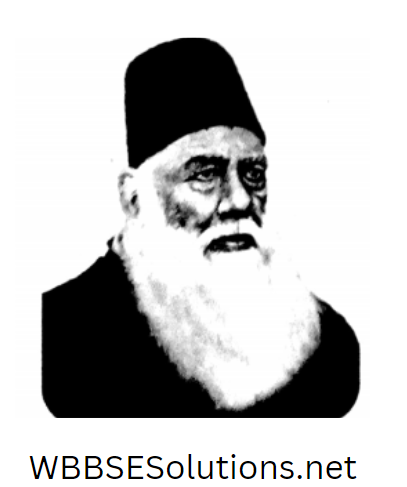
3. Features:
This Movement aimed at the universal progress of Muslim society with the help of the British.
This Movement gave rise to the concept that the Hindus and the Muslims were two different communi ties.
The origin of this movement was Aligarh College where students from all categories were not admitted. So people from all strata of society could not participate in it.
The movement faced opposition from the orthodox and non-reformist manuals and maulvis.
2. Role of Syed Ahmed Khan:
1. Educational reforms:
Sir Syed Ahmed founded an English medium school at Ghazipur in 1864 to spread English education. He established the ‘Scientific Society in 1865 to create awareness about science among Muslims.
He established the ‘Committee for the Advancement of learning among the Muhammedans of India’ for the all-around development of the Muslims.
He established the Anglo-Oriental College to foster higher learning among the youth. This college became Aligarh University later on.
2. Social reforms:
Sir Syed Ahmed tried to create an awareness among Muslims against the malpractices like the talaq (divorce) system, child marriage, and polygamy.
He tried to modernize Muslim society with the help of scientific thinking. He tried to remove conservatism from society by providing a rationalistic explanation of the Quran.
3. Political reforms:
Syed Ahmed aimed at extracting different social and political rights for Muslims by making them participate in national politics in large numbers.
The United Indian Patriotic Association was founded by Theodor Beck in 1888 as a parallel organization of the National Congress.
Theodor Beck founded the ‘Mohammedan Anglo-Oriental Defence Association of Upper India’ in 1893 to protect the interests of the Muslims.
Chapter 5 Reaction To Colonial Rule: Cooperation And Revolt Topic A Reformation Movement Short Analytical Type Questions
Question 1. Why did the Indians need to learn the English language during colonial rule?
Answer:
Indians Need To Learn The English Language During Colonial Rule:-
Western education was introduced in India during the rule of the East India Company to provide English education to the Indians.
1. Motive of government:
The government had realized the difficulty of bringing administrative supervisors from England. It involved a lot of expenses.
So they wanted to create an educated class among the Indians who would remain loyal to the British and help them to carry out administrative tasks.
2. Motive of Indians:
English education would enable the Indians to participate in the economic activities of the Company. So they believed
that their children would be able to secure jobs easily if they knew the English language well.
Question 2. What were the reasons for the dissatisfaction of the middle class against the British government?
Answer:
Reasons For The Dissatisfaction Of The Middle Class Against The British Government:-
1. Colonial rule and oppression:
The middle class was completely disappointed and annoyed with the colonial rule and the oppressive measures.
2. Deprivation of Indians from high government posts:
The English government deprived the Indians of important posts in the government in spite of their high education and capability.
The middle class was also annoyed at the British policy of holding the Civil Service Examination in England.
3. Repressive measures:
The educated middle class of India was completely disillusioned by the repressive measures adopted by the British government.
Question 3. What was the role of the press in the forming of public opinion?
Answer:
Role Of The Press In The Forming Of Public Opinion:-
The press played an important role in forming public opinion in favor of educational and social reforms.
In 1780, an English merchant named James Augustus Hicke published the ‘Bengal Gazette’, the first newspaper in India.
He published information impartially and fearlessly through his journal which enlightened the public but offended the Company.
In 1818, two more journals ‘Digdarshan’ and ‘Samachar Darpan’ were published under the initiative of Marshman, a missionary of Sreerampur.
Question 4. Name some elite families of Kolkata in the 19th century. How did they estab- lish themselves as the bourgeoise or the middle class?
Answer:
Some Elite Families Of Kolkata In The 19th Century:-
Some of the aristocratic families of Kolkata in the 19th century were the Tagores of Jorasanko, the Thakurs of Pathuriaghata, the Duttas of Hatkhola, the Ghoshals of Khidderpore,
the Devs of Shovabazar and the Sinhas of Paikpara.
These families came into contact with western education and secured jobs in the Company at low and medium posts by virtue of their intellect and endeavor.
Afterward, they established themselves as the ‘bourgeoise’ or ‘the middle class’ in society.
Question 5. What is meant by Suttee or Sati?
Answer:
Suttee Or Sati:-
The system of Suttee or Sati was prevalent in Hindu society at the beginning of the 19th century.
When a man died, his widow was compelled to sit on the pyre in her bridal dress and burn herself along with her husband’s dead body.
Again, a number of musical instruments were played to suppress the shrieks of the widow while the onlookers broke out into inhuman mirth.
This ghastly practice of burning widows alive was called Sati.
Question 6. How did Rammohan fight against the Sati system?
Answer:
Rammohan fought Against The Sati System:-
Rammohan Fought Against The Sati System As Follows:-
Rammohan Roy organized a strong movement to stop the inhuman practice of Sati.
1. Explanation of treatises:
He explained different religious treatises to testify that Sati is antireligious.
2. Building up public opinion:
He tried his best to organize public opinion against the practice of Sati.
3. Petition the in British Parliament:
Rammohan proved that the Sati system was both unjust an antireligious.
He also submitted a petition containing the signatures of distinguished citizens to the British parliament.
4. Anti-Sati legislation:
Ultimately Governor-General Bentinck supported Rammohan. and the legislation for abolishing Sati was passed in 1829.
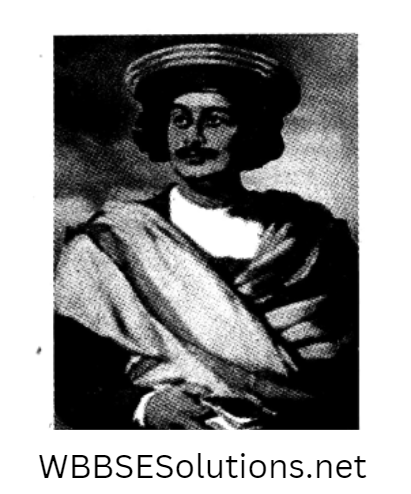
Question 7. Why did Rabindranath call Rammohan, The father of the Indian Renaissance? Who unified the three branches of the Brahmo Samaj?
Answer:
Rabindranath Call Rammohan, The Father Of The Indian Renaissance:-
Rammohan was the pioneer or maker of modern India in the light of rationalism and liberal thinking.
Possessed of modern rationalistic ideas and a secular attitude, he was the first to talk about the formation of a superstition-free society and preaching a superstition-free religion.
He was the first Indian to follow the liberal ideals of the west. So Rabindranath Tagore paid him a tribute by the Indians calling him the ‘Father of the Renaissance.
In 1902 the Adi Brahmo Samaj founded by Devendranath Tagore, the Indian Brahmo Samaj was founded by Keshav Chandra Sen and
the Sadharan Brahmo Samaj founded by Shivnath Shastri and Anandamohan Bose was unified by the efforts of Deshbandhu Chittaranjan Das and it was renamed as ‘Brahma Sammilan Samaj’.
Question 8. Give a short account of the introduction of Widow Remarriage in Hindu society.
Answer:
Introduction Of Widow Remarriage In Hindu Society:-
A remarkable achievement of Pandit Ishwar Chandra Vidyasagar was to get the sanction of the Government to introduce widow remarriage in Hindu society.
1. Endeavour:
Vidyasagar wrote essays in the ‘Sarvashuvakari’ and ‘Tatwabodhini’ about the necessity of the remarriage of widows and their independence, to prevent the legislation from getting annulled.
He also proved the validity of widow remarriage from the religious point of view by quoting lines from the Parashar Samhita.
2. Legislation for widow remarriage:
The Hindu Widow Remarriage Act was passed by Lord Dalhousie and it was the result of Vidyasagar’s efforts.
Later on, this act was opposed by Bal Gangadhar Tilak. However, 60 widow remarriages were held between 1856 and 1866 under his initiative.
Question 9. Why is Vidyasagar called the ‘traditional modernizer”?
Answer:
Vidyasagar Called The ‘Traditional Modernizer”:-
Vidyasagar was the pioneer of educational reforms in Bengal in the second half of the 19th century.
He felt that western education was necessary to develop rational thinking but the medium of instruction should be vernacular for a better understanding of the subjects.
Therefore, he stressed the establishment of Bengali medium schools and himself took the initiative of establishing model schools in the districts.
He believed that the overall progress of Indians was possible through the amalgamation of the oriental and the western.
So he introduced the study of the English language at Sanskrit College.
Since he was a realist Dr. Amalesh Tripathi calls him a ‘traditional modernizer’. i.e., an advocate of traditional modernism.
Question 10. Why did the Young Bengal movement fail?
Answer:
Young Bengal Movement Fail:-
The reasons for the failure of the young Bengal movement are as follows
1. Opposition to Hindu religion and traditions:
The enthusiastic members of the Young Bengal Group had sharply attacked the Hindu religion and traditions.
2 Urban-centric Characters:
The Young Bengal movement was chiefly confined to the city and the educated class.
3. Lack of organized agenda:
The Young Bengal group had no constructive program and they also could not present any alternative social system.
Question 11. What were the two main objectives of the social reform movements of the 19th century?
Answer:
Two Main Objectives Of The Social Reform Movements Of The 19th Century:-
1. Reduction of social discrimination:
The social reform movements in the 19th century tried to do away with social discrimination under the collective leadership of Brahmo Samaj, Arya Samaj, and Prarthana Samaj.
The main motive of these reform movements was to put an end to casteism and racial discrimination.
2. Elimination of social malpractices and superstitions:
The reform movements aimed at cleansing the Hindu society of malpractices and superstitions which had been infesting it for a long time.
The movements aimed at the expansion of education, the establishment of rationalism, and the elimination of superstitions.
Question 12. What is meant by ‘Three laws”?
Answer:
Three Laws:-
One of the outstanding achievements of the Indian Brahmo Samaj in the sphere of social reformation was to compel the Government to pass ‘Three Laws’ in 1872.
It was achieved under the able leadership of Brahmanand Keshav Chandra Sen. The provisions of this law are
- abolition of polygamy and cultism,
- prohibition of child marriage,
- recognition of intercaste marriage.
Question 13. Explanation Shri teaching of ‘Jata Mat Tata Path’.
Answer:
Shri Teaching Of ‘Jata Mat Tata Path’:-
Exponent:
Shri Ramkrishna Paramahansdeva was the exponent of the doctrine “Jata Mat Tata Path”.
Through this doctrine, he taught the people to bring about coordination among the different religions instead of opposing each other.
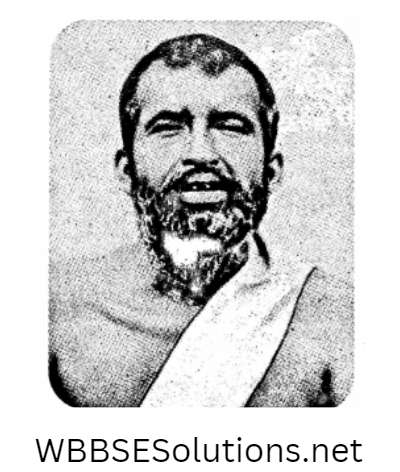
2. Literal Meaning:
Though we search for God by following different paths as shown by different religions, our aim is the same i.e., communion with God.
3. Significance:
Shri Ramkrishna has brought out the main essence of all religions exquisitely. He has said that all religions are equally true.
God is one but is called by different names just as the same water is called by different names in different languages.
Question 14. How was the India of Swami Vivekananda’s dream?
Answer:
Dream Of Swami Vivekananda’s About India
Swami Vivekananda was the greatest thinker, philosopher, and preacher of nationalism not only in India but also in the world. He was also the architect of building ‘New India’.
Swamiji dreamt of an India where there would be no shrieks of hunger, exploitation for self-interest, oppression for profit, or neglect for achieving glory.
He wanted India to develop as the home of true human beings. He regarded India as a holy land and said that truth would die with the death of India.
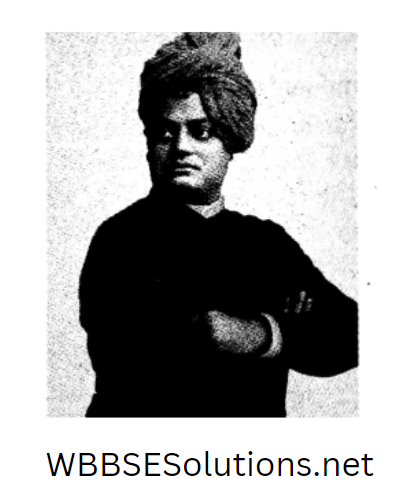
Question 15. Mention some important features of the Aligarh movement.
Answer:
Important Features Of The Aligarh Movemen:-
Some features of the Aligarh movement were as follows
- It tried to bring about the overall development of the Muslims with the help of the British government.
- The poor, who formed the majority, did not participate in the movement. Only some zamindars of UP and educated middle-class people participated in it.
- This movement alienated the Muslims from the Hindus because it was confined only to the Muslims.
- This movement has two facets one was conservative and anti-British and the other was modern, progressive, and loyal to the British.
Question 16. Who was Pandita Ramabai?
Answer:
Pandita Ramabai:-
Introduction:
Some women took the initiative of spreading education among women in the 19th century. Pandita Ramabai was one of them.
She came from a Brahmin family but married a Sudra and so she had to face social resistance.
1. Achievements:
Ramabai was a very determined lady. After becoming a window she went to England with her daughter and studied medicine.
She returned to India and made a home for the widows. She also launched a movement on behalf of the widows in western India.
Question 17 What were the limitations of the reform movements?
Answer:
Limitations Of The Reform Movements:-
The reform movements of the 19th century had some limitations.
1. Lack of reform universality:
The movements were mainly confined to the educated middle class and the upper class. The poor and rural masses had nothing to do with them. So these movements lacked mass character or universality.
2. Hindu-centric:
The Brahmo Samaj movements, except the Aligarh movement, were concerned only with the Hindus. These movements were launched to safeguard the interests of the Hindus.
Question 18. Briefly discuss Shri Ramkrishna’s ideal of harmonization of all religions.
Answer:
Shri Ramkrishna’s Ideal Of Harmonization Of All Religions
1. Principle:
According to Ramkrishna, There were as many ways of attaining God as there were religions.
Through this view, he had actually advised the people to believe in the oneness of the different religions instead of coming into conflict.
2. Meaning:
He thought that everybody searched for the same thing, i.e., God though they followed different paths.
3. Significance:
Shri Ramakrishna beautifully explained the essence of all religions. He thought that every religion was true and God was one, though called by different names.
Question 19. What was the role of Swami Vivekananda in awakening national consciousness?
Answer:
Role Of Swami Vivekananda In Awakening National Consciousness:-
1. Awakening of patriotism:
Swamiji was the first person to infuse patriotism into the minds of the Indians.
He called upon the youths to carry out their duties towards their motherland and said that for the next fifty years, their motherland should be their only deity to be worshipped.
2. Building of new India:
Swamiji wanted to use youth power to build a new India. He emphasized the theory of ‘karma’ or ‘action’.
This clarion call inspired the Indian youths immensely and imbued them with the ideals of nationalism.
3. Preaching ideals:
His speeches and ideals created national consciousness in the hearts of the Indians.
Chapter 5 Reaction To Colonial Rule: Cooperation And Revolt Topic A Reformation Movement State Whether The Following Statements Are True Or False
Question 1. Devendranath Tagore established the Adi Brahmo Samaj
Answer: True
Question 2. Swami Vivekananda founded the Ramakrishna Mission.
Answer: True
Question 3. Rammohan Roy is called the ‘Father of modern India’.
Answer: True
Question 4. Keshab Chandra Sen founded the Atmiya Sabha.
Answer: False
Question 5. Rabindranath referred to Raja Rammohan Roy as the ‘Father of Indian Renaissance”.
Answer: True
Question 6. The Sadharan Brahmo Samaj was founded by Shivnath Shastri and Ananda Mohan. Bose.
Answer: True
Question 7. Keshab Chandra Sen founded the Nababidhan Brahmo Samaj.
Answer: True
Question 8. Vidyasagar established the Academic Association.
Answer: False
Question 9. The first Principal of Aligarh Mohammedan Anglo-Oriental College was Theodor Beck.
Answer: True
Question 10. Sir Syed Ahmed Khan was the leader of the Aligarh movement.
Answer: False
Question 11. Lala Hansraj founded the Dayanand Anglo- Vedic College.
Answer: True
Question 12. The Gurukul ashram was founded by Dayanand Saraswati.
Answer: False
Question 13. Michael Madhusudan Dutta translated Nil Darpan into English.
Answer: True
Chapter 5 Reaction To Colonial Rule: Cooperation And Revolt Topic A Reformation Movement Fill In The Blanks By Selecting The Appropriate Expressions From The Brackets
Question 1. The Prarthana Samaj was founded ________ (Keshab Chandra/Dayanand Saraswati/ Atmaram Pandurang).
Answer: Atmaram Pandurang
Question 2. The Brahmo Samaj was founded by ________ (Keshab Chandra/Vidyasagar/Rammohan).
Answer: Keshab Chandra
Question 3. An association called Paramahans Mandali was established by ________ (Sir Syed Ahmed Khan/Gopalhari Deshmukh/Keshab Chandra Sen).
Answer: Gopalhari Deshmukh
Question 4. ________ (Keshab Chandra Sen/Dayanand Saraswati/Mahadev Govind Ranade) founded the Arya Samaj.
Answer: Dayanand Saraswati
Question 5. The practice of throwing a girl child into the sea was forbidden by ________ (Dalhousie/Wellesley/Bentinck).
Answer: Wellesley
Question 6. ‘Anandamath was written by ________ (Rabindranath Tagore/Bankim Chandra Chattopadhyay/Swami Vivekananda).
Answer: Bankim Chandra Chattopadhyay
Chapter 5 Reaction To Colonial Rule: Cooperation And Revolt Topic A Reformation Movement Answer In A Complete Sentence
Question 1. Who established the Aligarh Anglo-Oriental College?
Answer: Sir Sayyid Ahmed Khan established the Aligarh Anglo-Oriental College.
Question 2. Who was Bijaykrishna Goswami?
Answer: Bijaykrishn Goswami was a prominent social reformer and religious figure in the 19th century.
Question 3. Who founded the Satyashodhak Samaj?
Answer: Jyotirao phule founded the Satyashodhak Samaj.
Question 4. Who was known as the ‘middle class’ in the 19th century?
Answer: In the 19th century, those who were at the intermediate stage of financial well-being came to be known as the ‘ middle class’.
Question 5. Who was called ‘Bhadralok’ in British India?
Answer: In British India, the middle-class people coming from the upper caste segment of the Hindu community were called ‘Bhadralok’.
Question 6. Which movement of Bengal influenced Vireshlingam Pantulu?
Answer: Brahmo movement of Bengal influenced Vireshlingam Pantulu.
Chapter 5 Reaction To Colonial Rule: Cooperation And Revolt Topic A Reformation Movement Select the most appropriate explanation for the following statement
Question 1. The Indian social and educational reformers thought that the progress of the country was possible with British rule.
- They had faith in the ideals of British colonialism.
- They regarded British culture to be modern and advanced.
- They thought that the progress of the country could be possible with administrative aid.
Answer: 1. They had faith in the ideals of British colonialism.
Question 2. At the beginning of the 19th-century attempts were made to implement social reformation laws in India.
- The evil customs and practices degraded colonial rule.
- The evil customs and practices created disorder in India.
- Evil customs and practices were still prevalent in India.
Answer: 3. The evil customs and practices were still prevalent in India.
Question 3. The newspapers played a significant role in the reformation of education and society.
- The description of the social practices of the British was published in the newspapers.
- The newspapers published news concerning education and reforms.
- We get information about social corruption and perverted culture from the newspapers.
Answer: 2. The newspapers published news concerning education and reforms.
Question 4. Statement Vidyasagar felt the need for English education simultaneously with Sanskrit education.
- He realized that coordination ought to be made between vernacular and English.
- The standard of English education was much higher than that of the vernacular.
- The standard of English education was much higher than that of Sanskrit.
Answer: 1. He realized that coordination ought to be made between vernacular and English.
Question 5. Vidyasagar set up model schools in different districts under his own initiative.
- The government was indifferent to the establishment of Indian educational institutions.
- As a sub-inspector of schools, he realized that the education budget was quite low.
- The British government was not interested in the spreading of indigenous education.
Answer: 2. As a sub-inspector of schools he realized that the educational budget was quite low.
Question 6. An opinion developed in favor of widow remarriage in Maharashtra.
- Widow remarriage had an adverse effect on Maharashtrian society.
- The widows organized a movement in favor of widow remarriage. Explanation
- The educated middle class took up the initiative of widow remarriage in Maharashtra.
Answer: 3. The educated middle class took up the initiative of widow remarriage in Maharashtra.
Question 7. Women’s education flourished in the second half of the 19th century.
- The British government provided grants and scholarships to bring women under the purview of education.
- The social reformers created pressure for the spread of women’s education on the government.
- Social and educational reformers set up institutions for women’s education in different areas.
Answer: 1. The British government provided grants and scholarships to bring women under the purview of education.
Question 8. The Brahmo movement was confined to the upper classes in society.
- The upper classes liked the Brahmo movement.
- The leaders of the upper classes made their agenda according to the interests of their own class.
- The upper classes formed the main pillar of society.
Answer: 2. The leaders of the upper classes made their agenda according to the interests of their own class.
Question 9. The social reformers made an attempt to explain the treatises accurately.
- Majority of the common. people became victims of evil practices in the name of religion.
- The explanation of the treatises was vague and complicated.
- Most of the explanations of the treatises were fictional and misleading.
Answer: 1. Majority of the common. people became victims of evil practices in the name of religion.
Chapter 5 Reaction To Colonial Rule: Cooperation And Revolt Topic A Reformation Movement Multiple Choice Questions
Question 1. Who is known as the ‘first modern man of India’?
- Raja Rammohan Roy
- Swami Vivekananda
- Mohammad bin Tughlaq
- Keshab Chandra Sen
Answer: 1. Raja Rammohan Roy
Question 2. The teacher at Hindu College was
- Bankim Chandra Chatterjee
- Derozio
- David Hare
- Keshab Chandra Sen
Answer: 2. Derozio
Question 3. Pandita Ramabai was related to
- Widow remarriage movement
- Anti-Sati movement
- Women’s education
- Removal of untouchability
Answer: 3. Women’s education
Question 4. Atmiya Sabha was founded by
- Rammohan Roy
- Swami Dayanand Saraswati
- Rajnarayan Basu
- Vishnu Shastri Pandit
Answer: 3. Rajnarayan Basu
Question 5. Mohammedan Literary Society was established on
- 1863
- 1866
- 1890
- 1880
Answer: 1. 1863
Question 6. In Madras Presidency, the movement of widow remarriage was started by
- Jyotirao Phule
- Sri Narayana Guru
- Vireshlingam Pantulu
- Vidyasagar
Answer: 3. Vireshlingam Pantulu
Question 7. ‘Nil Darpan’ was written by
- Dinabandhu Mitra
- Vidyasagar
- Ishwar Gupta
- Rabindranath Tagore
Answer: 1. Dinabandhu Mitra
Question 8. The modern name of the Metropolitan Institute
- Hindu College
- Vidyasagar College
- Ashutosh College
- Scottish Church College
Answer: 2. Vidyasagar College
Question 9. The Sati System was abolished by
- Lord Curzon
- Lord Bentinck
- Lord Ripon
- Lord Lytton
Answer: 2. Lord Bentinck
Question 10. The purification movement was initiated by
- Dayanand Saraswati
- Devendranath Tagore
- Atmaram Pandurang
- Jyotirao Phule
Answer: 1. Dayanand Saraswati

